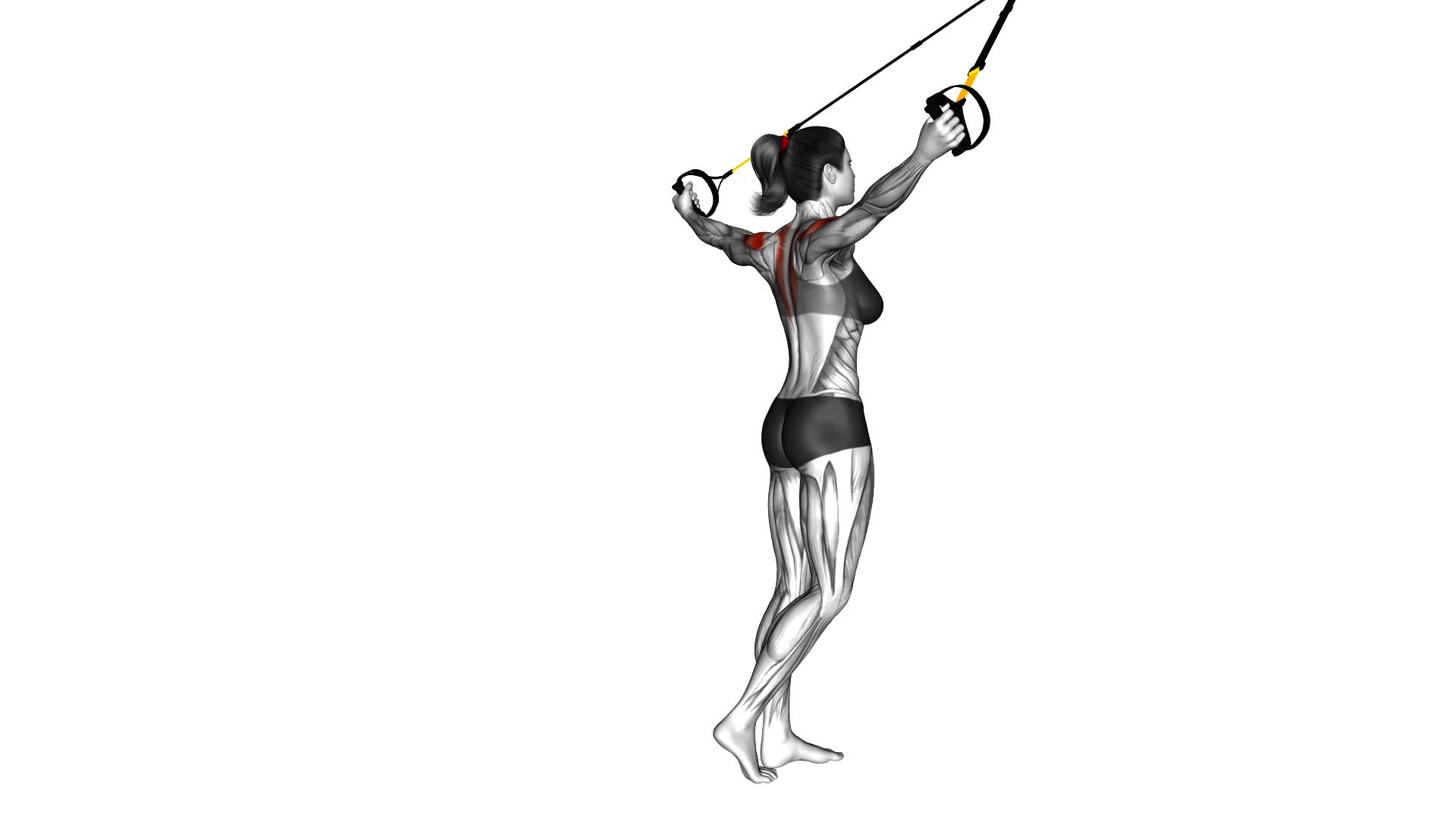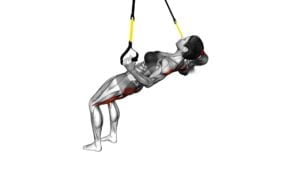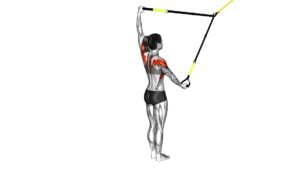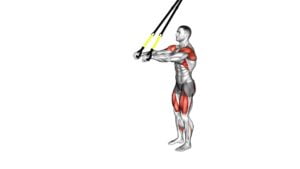Suspender Reverse Fly (female) – Video Exercise Guide & Tips

Get ready to strengthen and tone your upper body with the Suspender Reverse Fly! In this video exercise guide, we'll show you the proper form and technique for this effective workout.
Watch This Exercise Video
Whether you're a beginner or an experienced individual, we've got modifications and advanced variations to suit your fitness level. Plus, we'll share some tips for maximizing your results.
So grab your suspenders and get ready to fly towards a fitter you!
Key Takeaways
- The Suspender Reverse Fly is a beneficial exercise for strengthening and toning the upper body.
- It targets muscles in the upper back, shoulders, and arms, improving posture and stability.
- The exercise can be modified for different fitness levels, making it suitable for beginners and experienced individuals.
- To maximize results, it is important to maintain proper form, avoid using too much momentum, and focus on control.
Benefits of the Suspender Reverse Fly
To maximize your workout, incorporate the Suspender Reverse Fly exercise for improved upper body strength and posture. The Suspender Reverse Fly primarily targets the muscles in your upper back, shoulders, and arms. By performing this exercise, you'll strengthen the rhomboids, deltoids, and trapezius muscles in your upper back, as well as the rear deltoids and rotator cuff muscles in your shoulders. This will help to improve your overall upper body strength and stability.
To incorporate the Suspender Reverse Fly into your workout routine, start by attaching the suspenders to a sturdy anchor point, such as a pull-up bar or a smith machine. Stand facing away from the anchor point, holding onto the suspenders with your arms extended in front of you. Keeping your core engaged and your back straight, squeeze your shoulder blades together as you pull the suspenders out to the sides, away from your body. Hold this position for a moment, then slowly release back to the starting position.
To achieve the best results, aim to perform 2-3 sets of 10-12 reps of the Suspender Reverse Fly exercise. Remember to start with a weight or resistance level that challenges you but still allows you to maintain proper form throughout the movement. By incorporating this exercise into your workout routine, you won't only improve your upper body strength, but also enhance your posture and overall physique.
Proper Form and Technique
To perform the Suspender Reverse Fly exercise with proper form and technique, ensure that you maintain a strong and engaged core while pulling the suspenders out to the sides, away from your body. This exercise targets your upper back muscles, particularly the rear deltoids, and helps improve posture and shoulder stability.
Here are some important tips to keep in mind:
- Stand with your feet shoulder-width apart and slightly bend your knees.
- Keep your spine in a neutral position and avoid arching or rounding your back.
- Engage your core by pulling your belly button towards your spine.
- Start with your arms extended in front of you, holding the suspenders with an overhand grip.
- Slowly open your arms to the sides, squeezing your shoulder blades together as you do so.
- Pause for a moment at the end of the movement, then return to the starting position.
- Avoid using momentum or swinging your arms during the exercise.
- Remember to breathe throughout the movement, exhaling as you open your arms and inhaling as you return to the starting position.
To perform the Suspender Reverse Fly, you'll need a pair of suspenders and enough space to move your arms freely. It's important to choose suspenders that are sturdy and can withstand the resistance of the exercise. Make sure to adjust the length of the suspenders to a comfortable position before starting the exercise.
Modifications for Beginners
As a beginner, you can modify the Suspender Reverse Fly exercise by using lighter resistance or starting with a smaller range of motion. This will help you build strength and improve your form gradually.
Using lighter resistance, such as lighter dumbbells or resistance bands, will reduce the amount of strain on your muscles and joints, allowing you to focus on mastering the proper technique.
Starting with a smaller range of motion means that you won't need to lift your arms as high or spread them as wide. This modification can help you develop the necessary strength and stability in your shoulders before progressing to a full range of motion.
When performing the Suspender Reverse Fly, beginners often make the mistake of using too much resistance or trying to lift their arms too high. This can lead to muscle strain or injury, and may also compromise your form.
It's important to start with a weight that you can comfortably handle and focus on maintaining proper form throughout the exercise. If you find that you're struggling to keep your arms lifted or your back straight, it's a sign that you may need to reduce the resistance or range of motion.
By modifying the Suspender Reverse Fly exercise and gradually increasing the challenge as you become more comfortable, you can safely and effectively build strength in your upper back and shoulders.
Once you've mastered the beginner modifications, you can move on to more advanced variations for experienced individuals.
Advanced Variations for Experienced Individuals
For experienced individuals, try incorporating challenging variations into your Suspender Reverse Fly routine. These advanced progressions will take your workout to the next level and push your muscles to their limits. Here are some challenging modifications to try:
- Single-leg Suspender Reverse Fly: Lift one leg off the ground while performing the exercise to engage your core and challenge your balance.
- Plyometric Suspender Reverse Fly: Add an explosive jump to your fly motion, increasing the intensity and targeting your fast-twitch muscle fibers.
- Weighted Suspender Reverse Fly: Hold a dumbbell or kettlebell in each hand while performing the exercise to add extra resistance and build even more strength.
These advanced variations won't only challenge your muscles, but also improve your stability, coordination, and overall athletic performance.
Remember to start with lighter weights or modifications and gradually increase the difficulty as you become more comfortable and proficient. Always listen to your body and make sure to maintain proper form throughout each exercise. Push yourself, but never sacrifice technique for added difficulty.
Keep challenging yourself with these advanced variations and watch your strength and fitness levels soar.
Tips for Maximizing Results
Maximize your results by implementing these tips into your Suspender Reverse Fly routine. To ensure you get the most out of this exercise, it's important to avoid common mistakes and have the necessary equipment.
One common mistake to avoid is using too much momentum. It's crucial to maintain control throughout the movement to effectively target the muscles. Focus on engaging your shoulder blades and upper back muscles, rather than swinging your body. This will help you develop strength and stability.
Another mistake to watch out for is using improper form. Make sure you maintain a straight spine and avoid rounding your shoulders. Keep your core engaged and your chest lifted throughout the exercise. This will help you maintain proper alignment and maximize the effectiveness of the workout.
When it comes to equipment, you'll need a set of suspenders or resistance bands. These will provide the resistance necessary to challenge your muscles and promote muscle growth. Make sure the suspenders or bands are securely anchored to a sturdy object before starting the exercise.
Frequently Asked Questions
How Many Sets and Repetitions Should I Do for the Suspender Reverse Fly?
To determine the number of sets and repetitions for the suspender reverse fly, you should consider your fitness level and goals. Start with 2-3 sets of 8-12 repetitions, focusing on maintaining proper form throughout the exercise.
As you progress, you can increase the number of sets or repetitions to challenge yourself. Additionally, there are variations of the suspender reverse fly that you can incorporate into your workout routine to target different muscle groups and add variety to your training.
Can the Suspender Reverse Fly Help With Improving Posture?
The suspender reverse fly is a great exercise for improving posture. By targeting the muscles in your upper back and shoulders, it helps strengthen and stabilize your spine, promoting better alignment.
This exercise also enhances overall upper body strength, making you more resistant to injuries and improving your performance in other activities.
To perform it correctly, make sure to maintain proper form and technique by engaging your core, keeping your back straight, and squeezing your shoulder blades together.
Is It Necessary to Use Suspenders for This Exercise, or Can I Use Other Equipment?
You don't necessarily need to use suspenders for this exercise. There are alternatives you can try, such as resistance bands or dumbbells, to target the same muscles.
Additionally, there are different variations of the suspender reverse fly that you can explore to add variety to your workout routine.
Can the Suspender Reverse Fly Be Done Without a Partner?
Yes, the suspender reverse fly can be done without a partner. This exercise is great for targeting the rear deltoids and upper back muscles.
Beginners can modify the exercise by using lighter weights or resistance bands instead of suspenders.
However, people with shoulder injuries should exercise caution and consult with a healthcare professional before attempting this exercise, as it may aggravate their condition.
Are There Any Specific Muscles That the Suspender Reverse Fly Targets?
When it comes to the suspender reverse fly, it targets specific muscles in your body. Without the context of the exercise video, I can tell you that this move primarily works your upper back muscles, including the rhomboids and rear deltoids.
If you're a beginner, you can modify this exercise by using lighter weights or resistance bands.
Incorporating the suspender reverse fly into your workout routine can bring benefits like improved posture and upper body strength.
Conclusion
In conclusion, the suspender reverse fly is a highly effective exercise for strengthening the upper body, particularly the back and shoulder muscles. By maintaining proper form and technique, individuals can maximize the benefits of this exercise.
Beginners can modify the exercise to suit their fitness level, while experienced individuals can challenge themselves with advanced variations.
Remember to always consult a fitness professional before attempting new exercises and listen to your body's limits to avoid injury.

Author
Years ago, the spark of my life’s passion ignited in my mind the moment I stepped into the local gym for the first time. The inaugural bead of perspiration, the initial endeavor, the very first surge of endorphins, and a sense of pride that washed over me post-workout marked the beginning of my deep-seated interest in strength sports, fitness, and sports nutrition. This very curiosity blossomed rapidly into a profound fascination, propelling me to earn a Master’s degree in Physical Education from the Academy of Physical Education in Krakow, followed by a Sports Manager diploma from the Jagiellonian University. My journey of growth led me to gain more specialized qualifications, such as being a certified personal trainer with a focus on sports dietetics, a lifeguard, and an instructor for wellness and corrective gymnastics. Theoretical knowledge paired seamlessly with practical experience, reinforcing my belief that the transformation of individuals under my guidance was also a reflection of my personal growth. This belief holds true even today. Each day, I strive to push the boundaries and explore new realms. These realms gently elevate me to greater heights. The unique combination of passion for my field and the continuous quest for growth fuels my drive to break new ground.



